When the stars are right, when the planets of alien coordinates align in perfect syzygy, when the arcane progress of dark matter warps the cosmos into gravitations of sinister consequence, the Dead Gods may once again rise from their eonian slumber… but only if the proper rites are set in motion by those giftedly prescient of mortals. Chainsaw Abortion-ist Brian Pattison was one such a prophet who had succeeded before in the act: 1990′s Day of Death, an atrocity survived by none but a fanatical few, and the tale obscurely recounted within the scripture known as Glorious Times. Now 21 earth-years after that most notorious of receptions in the death metal saga, a wiser but no less maniacal Pattison determined the time was ripe for another extra-dimensional conjuration, with no less a death-god than Kam Lee in mind as his ultimate summoned entity. Naturally, the Buffalo territory of New York would again provide the setting, with the chosen temple for this installment being the rather profoundly-named Club Infinity.
An unprecedentedly cavernous venue, Club Infinity can house up to 500 or so bacchants before it becomes a legal deathtrap — yet attendance for the day must have been less than half of that numeral. Apparently, the local Buffalonians who would normally haunt the premises for their fix of alcohol and loud noises had absconded to a different corner of the land, lured up and away by the promise of an outdoor barbeque/live music festival of some sort. As it were, only the blackest-hearted diehards heeded the call to this cursed slice of suburbia, where memories from beyond time would once again climax in a lurid celebration of the horrific, the macabre, the rapacious and warfaring facets of existence from which fleeting mortality truly derives its meaning. Our lives — and indeed our deaths — would bear the distinct and indelible imprint of this Day as a scar that never heals, and whose free-flowing ichor blazes a sanguinary trail across ages…
Lethal Aggression: New Jersey’s crossover-thrash godfathers themselves had been the honorary headliners for the pre-Day of Death celebration, which of course had been successfully realized the previous Friday night; but for Saturday’s Day of Death proper, Lethal Aggression actually re-emerged from their dens — bleary-eyed and wracked with raging katzenjammer — at an ungodly brunch hour to be the very-fucking-first band in the proceedings, which was a display of tenacity mostly lost on the scant gathering of earlybirds. What followed was a forthright little blitzkrieg of their trademarked “drugcore” anti-anthems, which was made all the more special for the occasion with the return of classic-era guitarist Dave Gutierrez (though he may have been initially unrecognizable due to his new blue-dyed and bespiked hair), who additionally was commendable for drawing the wicked Lovecraft-inspired design for the Day of Death T-shirts. Towards the end of their timeslot, though, it became clear that vocalist John Saltz had most anticipated getting to the last song on the list — “No Scene” — as he had accidently launched into that whole vocal line during the beginning of penultimate song “Spooge”, causing the band to screech to a stop and start all over. In retrospect, the mixup should not have been too surprising, as the apathy-decrying, poseur-scourging lyric matter (the key verse being, “All you do is come to shows, sit around and stare”) was uncomfortably relevant enough to boil our blood. And this was an absolutely necessary kick-in-the-ass to start everything off on the right track.
Hubris: Being the first of four local bands to open up a 13-band procession is a task about as unpleasant as serving in the infantry during a foray into an uphill battle, and yet the cadre known as Hubris still mobilized for their set like the hungriest of mercenaries — corpse paint, wicked demeanors and all. Though they are a relatively new constellation in our Northern skies (to wit, all of their embryonic recordings thus far feature a drum machine because they could not, until recently, secure a faithful skinsman) Hubris’ style of black metal extrapolates directly from the most abrasive entries in the classical Scandinavian school, falling into a nebulous scape between Marduk’s Opus Nocturne and Immortal during their soulraping halcyon years with Demonaz. But at 4 p.m. in a sun-baked, poorly ventilated enclosure, the band’s blizzarding invocations of carnage-strewn battlefields and holocausted settlements were all but guaranteed to a tepid reception. Frontman Hellskald vehemently refused to let the standers-by off easily, however, and at numerous intervals demanded choruses of quasi-fascistic fistpumping from every slouched, beer-nursing figure in the near and far vicinity. It would be difficult to not be impressed by the young band’s charisma, and Hellskald’s exiting exhortation to “Rape angels! Drink their blood! Castrate God!” would basically set the tone for the remainder of the rituals to follow.
Seplophile: Attribute it to that everflowing stream of youthful vigor if you will, if that would most efficiently explain how Seplophile had the mettle to burn through one of their own setfuls of brutal death, just a few hours before they would entirely re-animate the godlike monolith of morbidity ‘From Beyond’ with living legend Kam Lee. Despite Seplophile’s ostensible “newcomer” status, they are a band that follows “The Old School Spirit” as their unshifting lodestar, and their drive is incited by memories of the vital role that the Buffalo scene had once taken in the death metal genesis (that is, before everyone and their grandparents emigrated to Florida). Their discography to date apparently features none but a single demo ‘…And Death Shall Have His Dominion’, so the boys did not exactly have a hell of a lot of material to choose over, but their formulas exhibit a certain potency of form and execution that echoes the advanced blastations formerly mastered by the early incarnations of Cannibal Corpse and Cryptopsy. If anything, the set was a reassurance that this fledgling local band had talent in abundance for the daunting role of Kam Lee’s backing band, and that would only further whet our bloodlusts for the Massacre to come.
Resist Control: Reportedly one of the all-time favorite newer Buffalonian bands of Brian Pattison himself, Resist Control followed swiftly on Seplophile’s heels with high-octane, classic hardcore-thrash madness that veers more towards the vehicle of purposeful, distinct narrative rather than uncontrolled paroxysms of angered words and misplaced epithets. This is the type of band that would incite violent, all-consuming pits amongst any gathering of punks and skins on a normal night, but of course since Resist Control were haplessly saddled on the first quarter of a 12-hour-long engagement, they were mostly just gawked at by those who weren’t caught up at the bar or the merchandise tables with all the luminous death metal celebrities. Still, the band gave voice to outrage as sonorously as a good “canary in a coalmine” ought, and it would be well-off if they could soon branch forth from their hometown Buffalo circuit and reach more disenchanted ears out in the rest of the Amerikan wasteland.
Sam Biles: Caught in similar circumstances with antihero-of-the-day Kam Lee, Sam Biles is an illustrious frontman who for some reason or other stands separated from his classic backing band — Hideous Mangleus, in this case — and so performed his best-loved songs at Day of Death eponymously, with the aid of youthful and capable hired hands. Somehow, Biles had managed to secure and implausibly import a star-crossed trio of Texan luminaries to stand in as his henchmen: on guitar, Francisco of HRA; on bass, Dave of PLF; and on the drumthrone, Matt of Blaspherian. This ad-hoc convocation had actually never before rehearsed with Biles, and yet their set for the evening came together with such natural beauty that a blind man would no less envision the old gang of Feev and the Brothers Bonde back at their respective spots (except — dare we say it — with tighter musicianship?). Preposterously outfitted with all of cast-iron armbands, leather pants and a fucking Ratt T-shirt, Biles prowled the peripheries of the stage like a caged beast whilst animating every disturbingly hilarious lyric with guttural prowess — and of course, the Tejas Squadron behind him did not once skip a stroke, faithfully re-enacting the catchiest death-throes behind material like “Question Your Motives” and “Burning Children” (“Remember kids, don’t play with matches! Aaaaaargh!“). If the audience gathered for the night had any doubts about Biles’ solo appearance, their apprehensions were completely quashed before the first song even ended; and by way of analogy, it could be correctly assumed that Kam Lee wouldn’t need Rick Rozz, Terry Butler or Bill Andrews to pull off the old Massacre songs with masterful [dis]grace.
Avulsion: The final of the local marauders to be showcased for the Day, Avulsion are elder guardians (est. ’92) of the Buffalo death metal tradition, though their essence is thoroughly imbued with eclectic dosages of hardcore and grind. Shrewdly tongue-in-cheek yet convicted in their anti-humanist manifestos, this band effectively mimics the torments of alienation through truncated songs patched together from ambiguously buzzing tremolo riffs. But perhaps their most distinctive asset is the uncanny throat-power of their frontman, who is able to switch so rapidly between a strident punk shout and a rattling growl that it was easy to be fooled into believing there was more than one lead vocalist at work. After completing a formidable listing of original compositions in record time, Avulsion thought well enough to conclude their set with a cover of Carcass’ “Empathological Necroticism”, which certainly tweaked the ears of all those yakkers in the vicinity who were only half-listening otherwise.
Goatcraft: The horned and cloven-hooved brainchild of keyboardist Jason “Lonegoat” Kiss, Goatcraft is purest piano metal unbounded from the conventional backdrop of screaming strings and timekeeping clangor, essentially comprising foreshortened sonatas that weave narratives and paint airs with bleak minimalism — obviously, this performance would be the one looked upon as the “oddball” on the bill by a large portion of the audience, if only for their bewilderment over aesthetics! Matters were not made much more agreeable due to the fact that The Lonegoat did not have access to his personal keyboard for the night, and thus had to make do with a rented piece of junk that would hiss and sputter at loathsomely frequent intervals. Though the technical difficulties as well as the piss-drunken interjections of certain audiencemembers shot through any semblance of good ambiance for this listening session, the one-man-band remained steadfastly transfixed at his post, only uttering a few words of exposition when necessary, or still more rarely betraying a glare from beneath a heavily corpsepainted and bloodsoaked brow. It may be a sad inevitability that those few ambitious souls who elect to play solo, ambient Metal in a concert setting will never have the right kind of audience, as people who walk the hessian path between Classical and Metal appreciations are still unmercifully uncommon, especially in regards to the U.S front. But for any matter, Goatcraft is still a promising work in progress; expect to hear more from this satyrid maestro in further compositions both personal and collaborative.
Druid Lord: The newest creative vehicle of former Acheron axemen Tony Blakk and Pete Slate, as well as their skin-hammering Equinox comrade Stephen Spillers, Druid Lord is a death/doom affair that draws its most prominent tributaries from the sludge-tainted fountainheads of Winter’s Into Darkness and Autopsy’s Mental Funeral, with perhaps the faintest hints of vintage Cathedral coursing noxiously through the solution. But whatever feeble combinations of band names one chooses for describing Druid Lord, it remains that this band gathers its purpose in delineating true imageries and sensations of Horror: the same inspiration for all music branching from the germinal genius of Black Sabbath. For their Day of Death appearance, Druid Lord had driven up north nonstop from their vantage point in the opposite pole of the country (Orlando, Florida), which might have added an honest dimension of bodily-excruciation to their already torturous live show. Though their 2010 LP Hymns for the Wicked lists Druid Lord as being a three-piece, they have since added Ben Ross as a rhythm guitarist, allowing The Great Slate to solo to his evil heart’s content whilst dense riffing frequencies are maintained. Bassist/vocalist Tony Blakk, already bedecked with plenty of frontman’s credentials for his years in Equinox, was practically thespian here in his snarled descantations of grisly fates. But for the song “All Hallows Evil”, he stepped aside to allow Kam Lee to take over on vocals — a very honorary guest appearance that would only be shared for the night by Derketa. Speaking of which…
Derketa: As of late, reunions in classic death metal have occurred on such a frequent scale that even the over-sanguine among us are becoming rather desensitized; an entity like Derketa, however, is so improbable a phoenix to rise from the ash that only the ignorant could fail to take notice. Formulated in the foundational ’80s era by Sharon Bascovsky and Terri Heggen, Derketa holds historical leverage alone for being the first female death metal band; of course, they earned their musical leverage by their demo recordings and the ‘Premature Burial’ EP, which featured decelerated-tempo, incredibly growly songs that sounded somewhere deep within the realms of Hellhammer and Nihilist. But the immediate intrigue that the band’s output garnered seemed to cause the very pressure that broke them apart, although Bascovsky put forth several honest attempts to keep Derketa’s name alive over the years, finally succeeding in a full reunion by 2006. Only five years later did the revitalized cult feel strong enough to begin live outings: the first three in their native Pittsburgh, and the forth to be Buffalo’s Day of Death 2011 — significantly, the girls (minus current bassist Robin Mazen, who was busy with Demonomacy back in Florida) had been in the audience for the fest’s 1990 edition. When it was finally time for Derketa to commence with their first out-of-state appearance and the opening sequence for “Premature Burial” was sounded, practically the whole fan-populace in the venue came flying to crush in front of the stage. Guitars sounded appropriately huge and menacing (although in the beginning only Sharon and Robin could be heard, as Mary Bielich’s distortion pedal had shorted out), and it’s apparent that over the years Sharon has trained her vocals to be even more fearsome. It was especially uplifting, though, to see Terri reprise her role as the original female death metal drummer — still the rarissimus avis of the genre — and as she was able to borrow Rottrevore’s massive drum kit, her blows were as sonorous as they could be. A brand new song called “Rest in Peace” (dedicated to Seth Putnam and others in a growing list of “dead metal guys”) was showcased: it could be the most doom-influenced track they’ve composed yet, which probably hints a lot at the overall aesthetic to expect on the imminent debut LP, In Death We Meet. And, as mentioned before, Kam Lee made one more guest appearance for the song ‘Last Rites’, growling along with his brightest female disciple for what must have been a very high point in the band’s lifespan.
Rottrevore: After Derketa and Sam Biles-technically-Hideous Mangleus, Rottrevore were the last in a series of revitalized Pennsylvanian cults to preside over Day of Death with their characteristically Northeastern, bowel-wrenching odes to the evil in man. Known best amongst the underground for their solitary full-length opus Iniquitous — an onerous, eldritch epitaph crafted after the most primeval echoes of the Stockholm and New York schools — the band almost inexplicably vanished from the scene shortly after the release, issuing no signs whatsoever from under their official banner save for the ‘Disembodied’ compilation pressed by Necroharmonic some time ago. This being so, their sudden resurgence back into action this year — signing with Spain’s Xtreem Music, dusting off unreleased songs, logging studio time with Erik Rutan for a new EP — is more than remarkable, and Day of Death would be honored with the first Rottrevore performance in nearly two decades. Frontman Chris Weber did not at all contrive much fanfare and flamboyance about the distinction, however, and preferred to be businesslike in his dispensation of aural punishment. Their set of course included all the choicest bits from Iniquitous (this humble narrator was partial to ‘Unanimous Approval’ and ‘Incompetent Secondary’, but everything honestly sounded true-to-form), and there was also a peppering of the new material which sounded to be very close in spirit to the classics, which is a very good thing indeed. This reunion show turned out to be a success in any respect, and the fact that it was all only a preview of what is to come can only confer the best of prospects.
Deceased: Who could have imagined that our most beloved Virginian bizarro-deathmeisters Deceased would be the only holdovers from the first incarnation of Day of Death? Granted, in the 21 years that have elapsed since then, the band has metamorphosed into an almost entirely different beast: the latest album Surreal Overdose features a tightly-crafted continuation of the ripping speed metal that has become their standard since the mid-’90s; and of course, King Fowley now vocalizes at the helm rather than behind the drumkit, backed by a quartet of mostly drafted-for-the-live-show mercenaries (including, for the very first time, guitarist Danzo of New York City-area hilaritythrashers Vermefüg). With a varied listing of the old savage classics mingled with everything up to the newborn creations, Deceased had a canonical time-travelling drama to offer their audience, although their stage time had to be disconcertedly hurried along due to some fascist schedule-policing on the venue’s part. This constraint was especially bogus for a born raconteur like King, who barely had an adequate moment to address his audience between songs, yet he still strived for those full Deceased theatrics we’ve all come to expect, complete with fucked-up monster masks and all such related tomfoolery. Perhaps, in recognition of the spirit of Day of Death, Deceased should have traded out some of their later-period songs for more selections off the early milestone ‘Luck of the Corpse’ and so on, since the audience was uniformly comprised of old-school hessians hellbent on tradition. But whatever the case, it was gratifying to have one of the original fest participants return for the second incarnation — and how many bands other than Deceased truly demonstrate the longevity of the underground death metal practice?
Insanity: It would not at all be a droll exaggeration to nominate San Francisco’s Insanity as the least fortunate band in all of death metal, following from their absurdly tragical biography as the one-time most promising vanguards of the newly developing extreme style, poised at the very cusp of self-realization yet cruelly denied their seat in the pantheon due to terminal illnesses, crippling accidents, and the ever shifting sands of label-backed patronage. Fate is a bitch, as superhumanly tenacious frontman Dave Gorsuch knows only so well at this point, and Her cantankerous whims sure enough wrought hell on Insanity’s maiden voyage across the Northeast. The very first tour date in Toronto had to be cancelled due to issues with bordercrossing policies, and during that same time bassist Falko Bolte was sniffed out for drug possession and was summarily locked away in a local jail, for as long as it would take for his sentence to be issued. Shaved down to a trio with no low-end support, Insanity nonetheless soldiered onward to Club Infinity intent on following through on the warpath they had carved. Guitarist Ivan Munguia took over Falko’s vocal duties on the spot, and both guitarists turned up the bass on their amplifiers with the hopes of plastering up the frequency gap in their wall of sound. It was evident then that failure was decisively averted once the opening strains of ‘Attack of the Archangels’ sounded out across the hall, electrifying the East Coastal audience who had before only dreamed of bearing witness to California’s most mythical entity. Since Insanity’s complex, many-riffed compositions emphasize guitar theatrics over everything else, the lack of Falko did not distract too much from the live reenactments, and the normally-silent Ivan’s backup growls turned out to be commendably feral, especially for the newer material which draws more than usual from call-and-response vocal forms. But the high point had to be marked by the song “Fire Death Fate”, which might be declared the most well-known of all Insanity songs if mostly for the fact that Napalm Death did a cover of it on their ‘Leaders Not Followers’ tribute album: a rather late piece of evidence concerning the remarkably deep-rooted influence that Insanity exerted on British extreme metal. In all, Insanity’s appearance was laudable in spite of the hindrances that seem to perennially plague them, and your humble narrator would go on to follow the band for two more dates of the tour, which were similarly sublime beyond all belief and yet met with shockingly low turnout. But that, friends, is a story for another odd time and place…
Nokturnel: After Goatcraft and Sam Biles’ One-Off Backing Band, Nokturnel were the last of the fiends who flew up from Texas to play a set — although, most old-schoolers remember the band from when they were still based in their native New Jersey, rattling out an intriguingly odd permutation of Voivodian death-thrash on the oft-overlooked opus Nothing But Hatred (another lamentable victim of the doomstruck vessel that was JL America Records). But sadly, nothing at all from the back catalogue was to be on the menu for the night: Nokturnel were quite literally debuting a new drummer and it was simply not in their longterm interest to teach him anything other than their contemporary songs, which are structured and conceptualized out of a much different mindset than the ’90s fare. It was a let-down for the diehards — come to think of it, *everyone* who was gathered for Day of Death was essentially a diehard in some way (especially that magnificent bastard who adamantly demanded to hear “Nuke Seattle”: may you have Satan’s blessings) — but sets will be sets, and it was still fun to watch Tom Stevens shred like a maniac (until his guitar strap came flying off its peg in the middle of everything). We were, however, treated to some completely new material: “Demonic Supremacy” and “Ancestral Calling”, the latter of which was astonishingly pulled off despite the drummer’s inexperience of ever rehearsing it. But at the end of it all, when Tom and the gang were packing it up, the restless energy in the room very palpably spiked to the critical mass: with Nokturnel down, the strike of the fatal hour was fast approaching with the grand finale…
Kam Lee/Seplophile: Primogenitor, mastermind, chieftain, elder god — in death metal, these honorary titles can only officially be coronated onto one Kam Lee. As vocalist for the overwhelmingly foundational bands Death and Massacre, it was Kam who devised the guttural vocal approach closest associated with the genre; and — as is only natural for a Samhain-born son — it was also Kam’s profound knowledge of literary and cinematic Horror, as well as the darker facets of world history that gave concept and soul to an artistic movement. Though his deathgrowls became the stuff of legend early on in the ’80s tapetrading network, his best known contribution is arguably the full-length Massacre album From Beyond, and the fact that this meisterwerk would be fully re-concerted for Day of Death [or should it have been called “Asscrack-of-Morning of Death” at this point?] imparted a dizzying sense of disbelief on the intimate, rabid crowd clinging in front of the stage. But indeed, it wasn’t a collective delusion: the familiar hearkening of “Dawn of Eternity” resonated true through us all, and surely enough Kam Lee stepped forth from the shadows, with Seplophile’s instrumentalists trailing close behind. Previously, Kam had worn a Bone Gnawer shirt for lounging around with his fans and peers off-stage, but for this set he switched to one bearing a “Herbert West: Reanimator” logo — of course, very appropriately referring to the film based on the Lovecraft novella of the same name, with its central theme of profligate science hideously inverting the laws behind life and death. What followed was a set that went by a true-to-album, track-by-track order of those nine anthems we all know better and love better than family; Kam’s live execution captured the full, terrifying intensity of the recordings of his youth, and his ribald yet quickwitted banter in between is always prime entertainment. All the while, the axemen of Seplophile darted to and fro across the stage like winged nightgaunts, and considering how the band had only three rehearsals with Kam to prepare for the night, their performance was almost too good to be true. When “Corpse Grinder” finally ground everything to a halt, Kam and the boys made a hasty exit… but everyone knew the slaughter couldn’t possibly be over yet! And in no time, of course, the spotlights flickered back on and Kam had indeed returned with a few bonuses in store. There was “Provoked Accurser” from the fabled single of the same name, a cover of Impetigo‘s “Boneyard”, a ridiculously fun cover of “Skulls” by the Misfits (which Kam introduced with a paean to punk’s crucial relation to death metal’s genealogy), and finally the ‘Inhuman Condition’ EP’s cover of Venom’s “Warhead” (similarly introduced with reverent words for the Newcastle trio, and how they were responsible for Kam’s fateful crossover from punkship to metaldom). Kam also took advantage of his stagetime to relate some news concerning future exploits: apparently, he has rekindled his alliance with veteran Massacre/Obituary guitarist Allen West, and the duo are in the midst of a scheme Kam has decided to name “Corpse Rot” — a portmanteau of the Massacre song “Corpse Grinder” and the Obituary song “Slowly We Rot”… naturally! And with that, the stars again shifted into benign coordinates and the glorious spell was broken, yet the harrowing tale would be scribed immortally within the Necronomicon of death metal’s saga. For this Day would surely be the last Day that Kam Lee would perform those classic Massacre songs live in concert, and those who missed it, have missed it for all eternity.
-Thanatotron-
No CommentsTags: American Death Metal, Brutal Death Metal, death metal, Death Metal Culture, Grindcore, Progressive Death Metal, Thrash
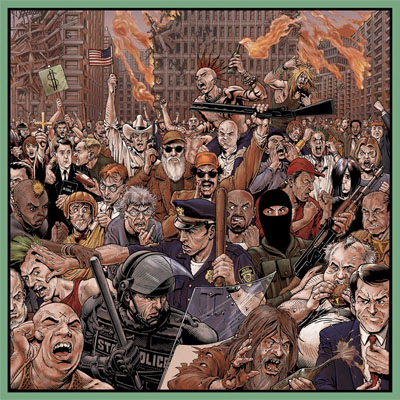 Birth A.D., the “continuation thrash” band that picked up where DRI’s Four of a Kind and SOD’s Speak English Or Die left off and then took the style to new levels of insanity, will unleash its full-length album I Blame You on April 1, 2013.
Birth A.D., the “continuation thrash” band that picked up where DRI’s Four of a Kind and SOD’s Speak English Or Die left off and then took the style to new levels of insanity, will unleash its full-length album I Blame You on April 1, 2013.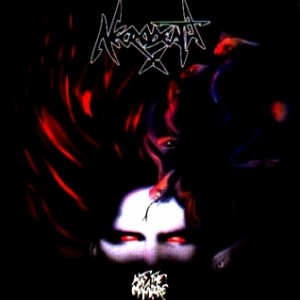
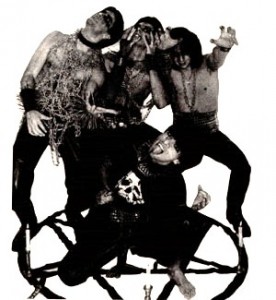 The sensual Italian attack in Into the Macabre, enveloped by the scents of leather, sweat and blood, is by no accident a bastard brother of the proto-war metal invocations of Morbid Visions and INRI, while the technical details show that the necro-warriors spent years studying the works of Slayer and Destruction. Most of all, Into the Macabre is an opera of rhythm, of intense vocal timings, stampeding blastbeats and onrushing chromatic and speed metal riffs which warp under the extremely analog old tape production into ambient paysages of ghostly frequency, much like the evil and infectious “Equimanthorn” of classic Bathory. Songs like “Necrosadist” seem to have the structure of a grotesque sexual orgy where each consecutive part tops the previous in volume and hysteria, with short breathing spaces in between to capture and organize the listener’s attention. Like the aforementioned Brazilian albums, Into the Macabre is one of the cases where music is about as far from an intellectual exercise as one gets, into the catacombs of a devil/alcohol/glue-possessed teenager’s brain but for the discerning and maniacal old school death metal listener there is no end to the amount of pleasures, revelations and evil moments that make it seem some transcendental guidance indeed dwells at the shrine of the unholy mystic.
The sensual Italian attack in Into the Macabre, enveloped by the scents of leather, sweat and blood, is by no accident a bastard brother of the proto-war metal invocations of Morbid Visions and INRI, while the technical details show that the necro-warriors spent years studying the works of Slayer and Destruction. Most of all, Into the Macabre is an opera of rhythm, of intense vocal timings, stampeding blastbeats and onrushing chromatic and speed metal riffs which warp under the extremely analog old tape production into ambient paysages of ghostly frequency, much like the evil and infectious “Equimanthorn” of classic Bathory. Songs like “Necrosadist” seem to have the structure of a grotesque sexual orgy where each consecutive part tops the previous in volume and hysteria, with short breathing spaces in between to capture and organize the listener’s attention. Like the aforementioned Brazilian albums, Into the Macabre is one of the cases where music is about as far from an intellectual exercise as one gets, into the catacombs of a devil/alcohol/glue-possessed teenager’s brain but for the discerning and maniacal old school death metal listener there is no end to the amount of pleasures, revelations and evil moments that make it seem some transcendental guidance indeed dwells at the shrine of the unholy mystic.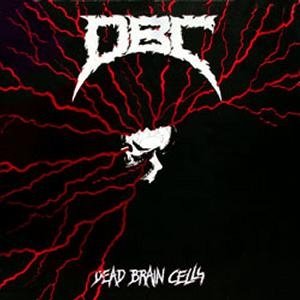
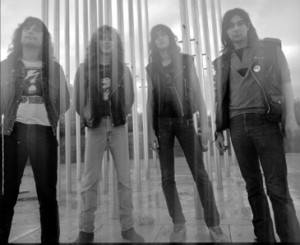

 On first listen some would easily assume that this release were a mere product of nostalgia of underground metal of the 1980′s, at least indicated so by the production and indication that are present here. However this is death/speed/black metal firmly rooted in the underground
On first listen some would easily assume that this release were a mere product of nostalgia of underground metal of the 1980′s, at least indicated so by the production and indication that are present here. However this is death/speed/black metal firmly rooted in the underground 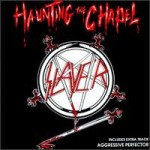 Showing a strong advancement in technique and an evolution towards a darker style that would be the staple of records to come by the band, Slayer throw off the camp shackles of their excellent first album, and give a more progressive approach to songcraft yet give more emphasis on repetition within individual riffs. The violent droning guitar timbre of Discharge makes itself ever more present whilst the musical language of Judas Priest and Angel Witch works itself within those patterns. The dissonant twin soloing of King and Hanneman is more suitable to this new direction also, whilst Lombardo’s aggressive battery finds more cohesion in using less variation and being more of an ambient backdrop than before, with Araya’s unmistakable rasp encoding itself sadistically within the depths. A bleak affair that summed up the apocalyptic meanderings of the speed metal movement and the embryonic beginnings of the death metal that was yet to manifest. -Pearson
Showing a strong advancement in technique and an evolution towards a darker style that would be the staple of records to come by the band, Slayer throw off the camp shackles of their excellent first album, and give a more progressive approach to songcraft yet give more emphasis on repetition within individual riffs. The violent droning guitar timbre of Discharge makes itself ever more present whilst the musical language of Judas Priest and Angel Witch works itself within those patterns. The dissonant twin soloing of King and Hanneman is more suitable to this new direction also, whilst Lombardo’s aggressive battery finds more cohesion in using less variation and being more of an ambient backdrop than before, with Araya’s unmistakable rasp encoding itself sadistically within the depths. A bleak affair that summed up the apocalyptic meanderings of the speed metal movement and the embryonic beginnings of the death metal that was yet to manifest. -Pearson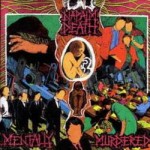 This work is like a convergence of Napalm Death and Carcass, having left From Enslavement to Obliteration and Reek or Putrefaction behind in order to expand on their styles, towards Harmony Corruption and Symphonies of Sickness respectively. By Napalm’s standards, at this point in their discography, these songs are quite lengthy and structured with an attention to detail that recaptures the subtle shifts in mechanical motion of the earliest side to Scum. This technique is re-invigorated by the cleaner production, relegating the extremity of fuzzy bass for the sake of a twin-guitar assault that creates an hypnotic and delusional sensation, and shows the input of Jesse Pintado who would go on to record another highly influential work of Grindcore – Terrorizer’s World Downfall. Composition is practically freed at very the earliest moments of songs onwards, unlike previous Napalm Death albums where these parts were used to establish exactly which single riff will become immersed in a barely discernable anarchic explosion for the rest of the 30 seconds of music. Instead, it’s given a more Death Metal treatment, e.g. in ‘The Missing Link’, the opening riff seems to degrade over time into smaller grinding patterns until the fragments are juggled like sacks of meat by morbid Death Metal riffs. This is where some of the tremelo melodies that would tear through the rotten wall of sound of Carcass finds its place, accompanied by the mocking lead guitars of Bill Steer. The human tornado, Mick Harris is even more precise than his previous effort, but doesn’t lose any of his epithet’s justification. Lee Dorrian’s vocals become more guttural and undecypherable, conceding to the futility of mainstream political discussion. The seeds of an approach closer in line with the burgeoning interest in Death Metal were sown here, simultaneously taking Grindcore one step further away from reaching the dead-end of short and simplistic outbursts of truncated riffs and hollow statements. -ObscuraHessian
This work is like a convergence of Napalm Death and Carcass, having left From Enslavement to Obliteration and Reek or Putrefaction behind in order to expand on their styles, towards Harmony Corruption and Symphonies of Sickness respectively. By Napalm’s standards, at this point in their discography, these songs are quite lengthy and structured with an attention to detail that recaptures the subtle shifts in mechanical motion of the earliest side to Scum. This technique is re-invigorated by the cleaner production, relegating the extremity of fuzzy bass for the sake of a twin-guitar assault that creates an hypnotic and delusional sensation, and shows the input of Jesse Pintado who would go on to record another highly influential work of Grindcore – Terrorizer’s World Downfall. Composition is practically freed at very the earliest moments of songs onwards, unlike previous Napalm Death albums where these parts were used to establish exactly which single riff will become immersed in a barely discernable anarchic explosion for the rest of the 30 seconds of music. Instead, it’s given a more Death Metal treatment, e.g. in ‘The Missing Link’, the opening riff seems to degrade over time into smaller grinding patterns until the fragments are juggled like sacks of meat by morbid Death Metal riffs. This is where some of the tremelo melodies that would tear through the rotten wall of sound of Carcass finds its place, accompanied by the mocking lead guitars of Bill Steer. The human tornado, Mick Harris is even more precise than his previous effort, but doesn’t lose any of his epithet’s justification. Lee Dorrian’s vocals become more guttural and undecypherable, conceding to the futility of mainstream political discussion. The seeds of an approach closer in line with the burgeoning interest in Death Metal were sown here, simultaneously taking Grindcore one step further away from reaching the dead-end of short and simplistic outbursts of truncated riffs and hollow statements. -ObscuraHessian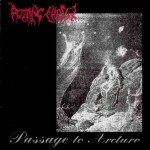 Warm, playful and overflowing with the abundance of inspiration in the rediscovery of ancient shamanic techniques of mystical metal creation, the Greek pioneers of Rotting Christ forsook the aggravated modern noise of grindcore in time to ride the wave of blackness that usurped the European metal underground. Remnants and glimpses of 80’s fast modern metal (Slayer) give way to an astral, luminous intensity of synthesizers and slowly picked melodies that suspend the themes for a moment to enable the mind to stop wandering and relish the unholy moment of concentration, in a yogic gesture of blackness. Few have ever used the crushing sonic world of black and death metal to so fully immerse in ethereal ritual, and such rare examples as Drawing Down the Moon preserve plenty of subtle reminders to this widely heard classic of European black metal. As their chaotic exhortations in countless zines of the period conclude, Rotting Christ’s hybrid of gothic and black metal aimed for an architecture of the infinite, regal sunsets of lost kingdoms whose landscapes are not for the eyes of mortals, except in dreams and in death. As “Forest of N’Gai” aptly proves, black metal was at its height when not contorted to fit the schemes of a political ideology or an orthodox Satanist movement, but like the great works of literature a realm of fantasy of its own whose symbols are rooted in our deepest unconscious fears and desires. This sub-space can then be used by the analytical mind to figure the patterns of generation for a multitude of creative, even lunatic, concepts. -Devamitra
Warm, playful and overflowing with the abundance of inspiration in the rediscovery of ancient shamanic techniques of mystical metal creation, the Greek pioneers of Rotting Christ forsook the aggravated modern noise of grindcore in time to ride the wave of blackness that usurped the European metal underground. Remnants and glimpses of 80’s fast modern metal (Slayer) give way to an astral, luminous intensity of synthesizers and slowly picked melodies that suspend the themes for a moment to enable the mind to stop wandering and relish the unholy moment of concentration, in a yogic gesture of blackness. Few have ever used the crushing sonic world of black and death metal to so fully immerse in ethereal ritual, and such rare examples as Drawing Down the Moon preserve plenty of subtle reminders to this widely heard classic of European black metal. As their chaotic exhortations in countless zines of the period conclude, Rotting Christ’s hybrid of gothic and black metal aimed for an architecture of the infinite, regal sunsets of lost kingdoms whose landscapes are not for the eyes of mortals, except in dreams and in death. As “Forest of N’Gai” aptly proves, black metal was at its height when not contorted to fit the schemes of a political ideology or an orthodox Satanist movement, but like the great works of literature a realm of fantasy of its own whose symbols are rooted in our deepest unconscious fears and desires. This sub-space can then be used by the analytical mind to figure the patterns of generation for a multitude of creative, even lunatic, concepts. -Devamitra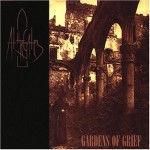 The original Gothenburg gloomy melody cult made one of their strongest statements on this early EP, pressed from demo to vinyl on the first year of the band’s existence. Fresh from life disrespecting bands such as Infestation and Grotesque, these Swedes nail the most desperate guitar harmonies since Candlemass, but infect them with the viral sensibility of a flux of death current. As if plugging the Sunlight Studios into your brains in direct interface, Svensson’s tremolos rip and rend mercilessly apart the soul of the beast that dared expose its true feelings of living in a world of hypocrisy and uncertainty. The band has preserved the most fragile moment of the Swedish death metal underground, the precarious balance between the catatonic psychosis of headbanging under alcoholic influence and the deep, burning, thoughtful soul of an encrypted Romantic in a world of pain and disguised memories. It all takes such tangible form in Tomas Lindberg’s cracking, maddened scream: “I am at the gates – Lord of Chaos – Let me sleep”. The fear and anger of At the Gates’ most revered albums will always remain something that divides audiences according to their response to such emotional cues, but “Gardens of Grief” is the un-terrorized, exuberant sound of youth that realizes the presence of death and dives into it headlong, appropriate to the Per Ohlin dedication in the liner notes. -Devamitra
The original Gothenburg gloomy melody cult made one of their strongest statements on this early EP, pressed from demo to vinyl on the first year of the band’s existence. Fresh from life disrespecting bands such as Infestation and Grotesque, these Swedes nail the most desperate guitar harmonies since Candlemass, but infect them with the viral sensibility of a flux of death current. As if plugging the Sunlight Studios into your brains in direct interface, Svensson’s tremolos rip and rend mercilessly apart the soul of the beast that dared expose its true feelings of living in a world of hypocrisy and uncertainty. The band has preserved the most fragile moment of the Swedish death metal underground, the precarious balance between the catatonic psychosis of headbanging under alcoholic influence and the deep, burning, thoughtful soul of an encrypted Romantic in a world of pain and disguised memories. It all takes such tangible form in Tomas Lindberg’s cracking, maddened scream: “I am at the gates – Lord of Chaos – Let me sleep”. The fear and anger of At the Gates’ most revered albums will always remain something that divides audiences according to their response to such emotional cues, but “Gardens of Grief” is the un-terrorized, exuberant sound of youth that realizes the presence of death and dives into it headlong, appropriate to the Per Ohlin dedication in the liner notes. -Devamitra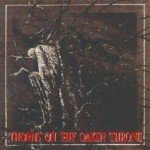 An all too brief EP from Finnish gloomophiliacs Wings, as ephemeral as the tortured existence that is enshrouded in these twisted sounds of darkness-raped melody. Almost like the missing tracks from Cartilage’s cult classic ‘The Fragile Concept of Affection’, this continuation goes further to explore the sombre moods of songs like ‘Why Do I Watch The Dawn?’, in their Replicant-like reflections upon the transience of a human existence placed between the crushing, vice-grip of nothingness. Wings don’t peturb the balance of pace of slower, more expansive lakes of hypnotic melody that made up Cartilage’s contribution to their split with Altar, but there is greater focus on creating a doomier atmosphere, leaving no space for the grinding riffs of the past incarnation – a technique that parrelleled the Swedish Unleashed on their first album. Instead, an older treatment is given to the bouncier riffs, which could be heard as Punkier passages, but as this EP comes together as a whole to reveal, these bridge the narrative that seems to span across both songs with a mid-pace tempo in which the drawn out melodies pass through towards an expressive, quite neoclassical riff of totality – encompassing all the hopes that are weighed down by all the sorrows in the journey towards death. This poem in two parts is a valuable recording of Death Metal history, as a valid direction for these Finnish musicians to have taken following the demise of Cartilage, with all their weird melodic knowledge as baggage. -ObscuraHessian
An all too brief EP from Finnish gloomophiliacs Wings, as ephemeral as the tortured existence that is enshrouded in these twisted sounds of darkness-raped melody. Almost like the missing tracks from Cartilage’s cult classic ‘The Fragile Concept of Affection’, this continuation goes further to explore the sombre moods of songs like ‘Why Do I Watch The Dawn?’, in their Replicant-like reflections upon the transience of a human existence placed between the crushing, vice-grip of nothingness. Wings don’t peturb the balance of pace of slower, more expansive lakes of hypnotic melody that made up Cartilage’s contribution to their split with Altar, but there is greater focus on creating a doomier atmosphere, leaving no space for the grinding riffs of the past incarnation – a technique that parrelleled the Swedish Unleashed on their first album. Instead, an older treatment is given to the bouncier riffs, which could be heard as Punkier passages, but as this EP comes together as a whole to reveal, these bridge the narrative that seems to span across both songs with a mid-pace tempo in which the drawn out melodies pass through towards an expressive, quite neoclassical riff of totality – encompassing all the hopes that are weighed down by all the sorrows in the journey towards death. This poem in two parts is a valuable recording of Death Metal history, as a valid direction for these Finnish musicians to have taken following the demise of Cartilage, with all their weird melodic knowledge as baggage. -ObscuraHessian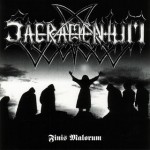 A true gem, Sacramentum’s first EP showcases a style that is melodic and emotive in a manner not unlike countrymen Dissection and Unanimated. Epic, catchy and well crafted compositions are multi-layered not unlike Emperor minus keyboards, the rush of guitar notes being vibrant and lively, with little emphasis towards a rhythmic expectation, as one would expect with most heavy metal and hard rock music. Simultaneously moody yet without being whiny, this early release by Sacramentum showcases a band who are able to master quality control and bring the best out of all the elements that define their music. Alongside At The Gates, artistically the finest Swedish metal act of the 1990′s. -Pearson
A true gem, Sacramentum’s first EP showcases a style that is melodic and emotive in a manner not unlike countrymen Dissection and Unanimated. Epic, catchy and well crafted compositions are multi-layered not unlike Emperor minus keyboards, the rush of guitar notes being vibrant and lively, with little emphasis towards a rhythmic expectation, as one would expect with most heavy metal and hard rock music. Simultaneously moody yet without being whiny, this early release by Sacramentum showcases a band who are able to master quality control and bring the best out of all the elements that define their music. Alongside At The Gates, artistically the finest Swedish metal act of the 1990′s. -Pearson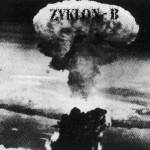 Fast, raging black metal with the fury of early Deicide and the sharp harmonizing typical of Mayhem and Immortal’s ‘Pure Holocaust’ come head to head, in the guise of technically precise, abrupt songs. Shouty hardcore vocals, warm synth overlaps, a near constant blastbeat and anti-humanist lyrical concepts indicate a desire by known Norwegian musicians to advance the aggression of the black metal style and shift it’s idealogical focus away from romantic nostalgia. This brief E.P. lacks the spark of Norway’s foundational acts, but remains an influential statement of the subgenre. -Pearson
Fast, raging black metal with the fury of early Deicide and the sharp harmonizing typical of Mayhem and Immortal’s ‘Pure Holocaust’ come head to head, in the guise of technically precise, abrupt songs. Shouty hardcore vocals, warm synth overlaps, a near constant blastbeat and anti-humanist lyrical concepts indicate a desire by known Norwegian musicians to advance the aggression of the black metal style and shift it’s idealogical focus away from romantic nostalgia. This brief E.P. lacks the spark of Norway’s foundational acts, but remains an influential statement of the subgenre. -Pearson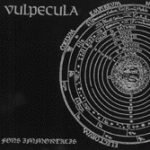 Who would have expected Chuck Keller to open the gates to very Orion itself after the folding of the aggressor squad par excellence Order from Chaos? As if a continuation of the promise of the astrological and alchemistic symbolism of the former bands’ lyrics, Vulpecula slows it down and strums soothing, yet vigorous melodies while the vocals multiple into wraith-like dimensions of rhythmic rasps and Keller’s leads occasionally burst into the aggressive, spasmous flight of an eagle amidst a thunderstorm. “Phoenix of the Creation” delves into exercises in authentic space synth, while “The First Point of Aries” harkens to the mid-paced woodland meditations that the Norwegians used to record at Grieghallen. Occasionally slightly hindered by the band’s eagerness to cram all the influences from Schulze to black metal into one short EP, the mere richness of it invites the ears to take their pleasure at will from the Babylonian garden of ponderous and prestigious movements that are achingly attractive and acceptable in their innocent refusal to complicate things with dissonance. Credit also goes for the lead guitar efforts of Keller on their traditional melodious injection which easily avoids the neutrality of more pop oriented bands trying to do the same. Almost like envisioning a “new age” approach to the genre, Vulpecula is an alien saucer amidst the orbit bound technologies of “progressive” death metal. -Devamitra
Who would have expected Chuck Keller to open the gates to very Orion itself after the folding of the aggressor squad par excellence Order from Chaos? As if a continuation of the promise of the astrological and alchemistic symbolism of the former bands’ lyrics, Vulpecula slows it down and strums soothing, yet vigorous melodies while the vocals multiple into wraith-like dimensions of rhythmic rasps and Keller’s leads occasionally burst into the aggressive, spasmous flight of an eagle amidst a thunderstorm. “Phoenix of the Creation” delves into exercises in authentic space synth, while “The First Point of Aries” harkens to the mid-paced woodland meditations that the Norwegians used to record at Grieghallen. Occasionally slightly hindered by the band’s eagerness to cram all the influences from Schulze to black metal into one short EP, the mere richness of it invites the ears to take their pleasure at will from the Babylonian garden of ponderous and prestigious movements that are achingly attractive and acceptable in their innocent refusal to complicate things with dissonance. Credit also goes for the lead guitar efforts of Keller on their traditional melodious injection which easily avoids the neutrality of more pop oriented bands trying to do the same. Almost like envisioning a “new age” approach to the genre, Vulpecula is an alien saucer amidst the orbit bound technologies of “progressive” death metal. -Devamitra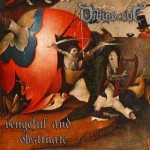 The first new release that’s being reviewed for 2010 and it’s already giving distinct impressions of the kind of quality that made 1993′s ‘As the Angels Weep’ a genuinely classic EP. Divine Eve keeps the form of this new material far simpler, stripping away the Death Metal-infected sludginess for a more rudimentary homage to early brutal music like Celtic Frost. ‘Vengeful and Obstinate’ makes its own unique statement by honing in on the nihilistic and warlike spirit of the Swiss legend’s To Mega Therion magnum opus, even invoking the same battle-horns on ‘Ravages of Heathen Men’ that bring focus to the beauty of conflict and strife in a meaningless universe. The varied tempo of grinding riffs set to a dirty bass guitar adds to the atmosphere of struggle as an outlet for this primitive, instinctual response to the world. ‘Whispers of Fire’ being the exception on this EP for the constantly up-tempo pace, it’s a pleasure to hear such slow and sludgy music churning visions of the darker universe beyond our lives of comfort and languish. The final and most devastating touch of ‘Vengeful and Obstinate’ is how Divine Eve makes extensive use of the piercing tone that Xan’s grating guitar setup produces, highlighting the spiral passage of powerchords by revealing their hidden, melodic architecture, ingenuiously managing to explain and enhance this rugged approach of legendary lineage. It’s about time the band produced a full-length and they’ve proved that they possess more than enough knowledge of unholy riffcraft to do so. -ObscuraHessian
The first new release that’s being reviewed for 2010 and it’s already giving distinct impressions of the kind of quality that made 1993′s ‘As the Angels Weep’ a genuinely classic EP. Divine Eve keeps the form of this new material far simpler, stripping away the Death Metal-infected sludginess for a more rudimentary homage to early brutal music like Celtic Frost. ‘Vengeful and Obstinate’ makes its own unique statement by honing in on the nihilistic and warlike spirit of the Swiss legend’s To Mega Therion magnum opus, even invoking the same battle-horns on ‘Ravages of Heathen Men’ that bring focus to the beauty of conflict and strife in a meaningless universe. The varied tempo of grinding riffs set to a dirty bass guitar adds to the atmosphere of struggle as an outlet for this primitive, instinctual response to the world. ‘Whispers of Fire’ being the exception on this EP for the constantly up-tempo pace, it’s a pleasure to hear such slow and sludgy music churning visions of the darker universe beyond our lives of comfort and languish. The final and most devastating touch of ‘Vengeful and Obstinate’ is how Divine Eve makes extensive use of the piercing tone that Xan’s grating guitar setup produces, highlighting the spiral passage of powerchords by revealing their hidden, melodic architecture, ingenuiously managing to explain and enhance this rugged approach of legendary lineage. It’s about time the band produced a full-length and they’ve proved that they possess more than enough knowledge of unholy riffcraft to do so. -ObscuraHessian
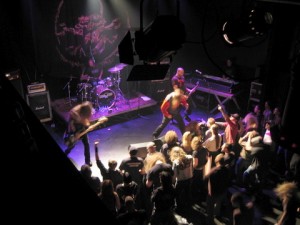 Entombed played a set that disappointed, and this was partially due a lack of their better material being played. Much of the setlist consisted of numbers that were lifted from their third full-length, Wolverine Blues and then onwards, with a lack of attention given to their more pioneering work that was put out on their first two albums, Left Hand Path and Clandestine. Songs were less death metal than they were an aggressive take on stoner rock, songs being much more inclined to the verse/chorus school of rock songwriting, the rhythms more inclined to provoke the shaking of hips and the tapping of feet than they were to bang heads. Whilst this was all good and competent, certainly the great soundtrack of an alcohol fueled evening in the capital of Eire, none of these works, as far as the reviewers opinion is concerned had the violent charge nor the momentum that characterized their legendary debut. Some credit will be given to the vocalist, whose onstage presence and frantic onstage manners gave more depth and urgency to songs that otherwise were devoid of it, and the guitarists tone was brilliant, the same buzzing, ‘chainsaw’ like tone that they helped pioneer back in the early nineties through maximum amplification. Entombed concluded their set with a brilliant rendition of Left Hand Path the staple and title track of their debut album, and it put a redeeming conclusion to what was an expertly performed, yet borderline mediocre set on occasions. It would be wonderful to hear what paths could be treaded if they realise the urgency that made their earlier music essential.
Entombed played a set that disappointed, and this was partially due a lack of their better material being played. Much of the setlist consisted of numbers that were lifted from their third full-length, Wolverine Blues and then onwards, with a lack of attention given to their more pioneering work that was put out on their first two albums, Left Hand Path and Clandestine. Songs were less death metal than they were an aggressive take on stoner rock, songs being much more inclined to the verse/chorus school of rock songwriting, the rhythms more inclined to provoke the shaking of hips and the tapping of feet than they were to bang heads. Whilst this was all good and competent, certainly the great soundtrack of an alcohol fueled evening in the capital of Eire, none of these works, as far as the reviewers opinion is concerned had the violent charge nor the momentum that characterized their legendary debut. Some credit will be given to the vocalist, whose onstage presence and frantic onstage manners gave more depth and urgency to songs that otherwise were devoid of it, and the guitarists tone was brilliant, the same buzzing, ‘chainsaw’ like tone that they helped pioneer back in the early nineties through maximum amplification. Entombed concluded their set with a brilliant rendition of Left Hand Path the staple and title track of their debut album, and it put a redeeming conclusion to what was an expertly performed, yet borderline mediocre set on occasions. It would be wonderful to hear what paths could be treaded if they realise the urgency that made their earlier music essential.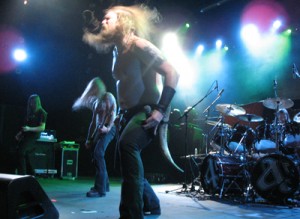 Amon Amarth played an excellent and intense set, mostly consisting of the melodic, fluid and anthemic traditional metal that they have come to be easily associated with. Infectious melodies and precise, double-bass lead drum rhythms bring to mind a hybrid of Blind Guardian and late period Immortal, whilst the muscle and simplicity of their music brings to mind fellow countrymen Unleashed in both the subject matter and the simplicity of the song structures. Musically Amon Amarth have an obvious strong commercial potential, sound highly accessible by the subgenre’s standards, and whilst they are not exactly breaking any new artistic ground, they are still workmanlike and this shows in what was a very well received and well performed set. Johan Hegg is a good front man and throughout the set uses the opportunity to incite the audience to terrace chant amidst his bellowing, whilst taking turns to consume from the mead horn that is his custom to bring on stage with him. Admittedly I would not consider these to be an act of the highest caliber, though they are unique in that they have one foot stood in the primitive and barbaric, with one firmly in the ability to reach out to a large audience. It was a privilege to be involved among the audience that night.
Amon Amarth played an excellent and intense set, mostly consisting of the melodic, fluid and anthemic traditional metal that they have come to be easily associated with. Infectious melodies and precise, double-bass lead drum rhythms bring to mind a hybrid of Blind Guardian and late period Immortal, whilst the muscle and simplicity of their music brings to mind fellow countrymen Unleashed in both the subject matter and the simplicity of the song structures. Musically Amon Amarth have an obvious strong commercial potential, sound highly accessible by the subgenre’s standards, and whilst they are not exactly breaking any new artistic ground, they are still workmanlike and this shows in what was a very well received and well performed set. Johan Hegg is a good front man and throughout the set uses the opportunity to incite the audience to terrace chant amidst his bellowing, whilst taking turns to consume from the mead horn that is his custom to bring on stage with him. Admittedly I would not consider these to be an act of the highest caliber, though they are unique in that they have one foot stood in the primitive and barbaric, with one firmly in the ability to reach out to a large audience. It was a privilege to be involved among the audience that night.
